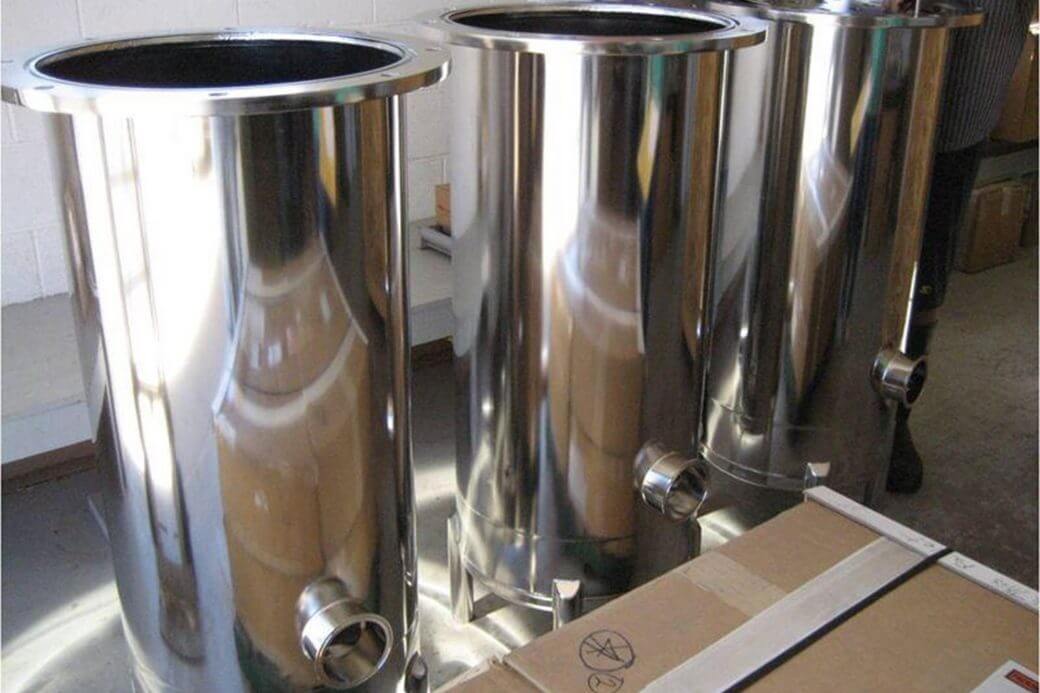
Stainless Steel Finish Designations
Due to the different alloys, variations in the final finish may occur. Variations may also occur by the type of buffing equipment used, type and size of the buff wheels, peripheral of the buff, the type of abrasive composition used, and operator`s technique.
When using automatic equipment, the operator technique is replaced by a mechanical system controlling such variables as pressure, time cycle, conveyor speed, and contact time.
Guidelines for Comparing Stainless Steel Finishes
 Roughness average (Ra) is the most accurate and is measured in microinches. Grit and polish numbers are dependent on methods and materials used and are a subjective assessment.
Roughness average (Ra) is the most accurate and is measured in microinches. Grit and polish numbers are dependent on methods and materials used and are a subjective assessment.
Basic Stainless Steel Sheet Finish Designation
The following list of stainless steel sheet finish designations includes a short description of how each surface may be obtained.
- Unpolished Finish No. 1: A dull finish produced by hot rolling to a specified thickness, followed by annealing and descaling.
- Unpolished Finish No. 2D: A dull finish produced by cold rolling to a specified thickness, followed by
annealing and descaling. May also be accomplished by a final, light roll pass on dull rolls. - Unpolished Finish No. 2B: A bright finish commonly produced in the same way as 2D except that the annealed and descaled sheet receives a final, light cold-roll pass on polished rolls. This is a general-purpose, cold-rolled finish, and is more readily polished than the No. 1 or No.2D finishes.
- Polished Finish No. 3: An intermediate polished finish generally used where a semi-polished surface is required for subsequent finishing operations following fabrication, or as a final finish with a 50- or 80-grit abrasive compound.
- Polished Finish No. 4: A general-purpose bright polished finish obtained with a 100-180 mesh abrasive, following initial grinding with coarser abrasives.
- Buffed Finish No. 6: A soft satin finish has a lower reflectivity than a No.4 finish. It is produced with a greaseless compound, #200 grit, top dressed with white rouge or chromium green rouge.
- Buffed Finish No. 7: A highly reflective finish produced by buffing a surface that has first been refined to approximate a No. 6 finish, then buffed lightly with a white rouge without removing satin finish lines.
- Buffed Finish No. 8: The most reflective finish commonly produced. It is obtained by flexible polishing with successively finer abrasive compounds, then buffing extensively with a very fine chromium green rouge bar compound.
Mill & Architectural Finishes
The main concern of most fabricators of stainless steel is to remove welds and machining marks and blend and simulate the final finish with the original mill finish or the sheet or coil stock.
To refine the area of welds and machining marks, standard rough polishing procedures used are as those previously discussed above. Note that the final finish must closely approximate the original mill finish.
There are eight basic stainless steel mill finishes used in the industry by product designers and architects. Mill finish Nos. 3,4,6,7 and 8 are produced mechanically using some type of abrasive media and buffing wheels. Finish Nos. 3 and 4 have proven to be the most popular among fabricators of dairy, kitchen, cafeteria, chemical equipment, and architectural and decorative structures. The simplest way to produce these blended finishes is with string wheels coated with greaseless abrasive compositions containing 80, 120, or 180 grit abrasive, operating at relatively low speeds. Narrow, flat or curved areas can easily be blended with a portable power tool and a string wheel up to 8 inches in face width. Medium or very wide areas are finished with a string wheel log held with two hands or by two operators.
Such a polishing log is made of string wheel sections on the desired width shaft of a sufficiently powered portable tool. The greaseless compound is applied to the rotating string wheel log and allowed to dry for a few minutes. String wheel blending is then quickly accomplished in the direction of the lines of the original mill finish.
Mill finishes Nos. 6, 7, and 8 are most generally used on consumer products, although on some architectural sections they are produced for contrasting patterns.
Spec Pages (Non-PDF)
- Material Safety Data Sheet
- Alconox Msds
- Material Safety Data Sheet – Antox 73 E Manufacturer
- Aqueous Cleaning Procedures
- Blue Gold Industrial Cleaner – MSDS Safety Information
- Celco-1000-Rev-E.
- Citric Acid – Msds
- Electropolishing And Handling Components For High Purity Applications
- Electropolishing Stainless Steel Aircraft
- Electropolishing Stainless Steel Material
- EPS 1375
- EPS 2000
- EPS 2500
- EPS 4000
- Iron Reagent – Msds
- Isopropyl-MSDS
- Krytox-MSDS
- Methyl Ethyl Ketone
- Miccromask-MSDS
- Nitric Acid Passivation For Austenitic Type Stainless Steel
- Nitric-MSDS
- Oxygen System Safety
- Perchlor-MSDS
- Phenol-MSDS
- Potferro-MSDS
- Pro-Phx-MSDS
- Sohydroxsol-MSDS
- Versene-MSDS
